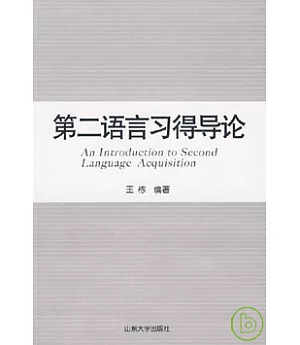在編寫本書時作者力求反映第二語言習得研究的最新成果,本着理論聯系實際、重點突出的原則,力求具有實用性和可操作性。全書共分11章,可分為三部分。第一部分包括第一、二、三章,目的是為讀者了解第二語言習得的方式和過程,本部分首先討論了第二語言習得的學科定位、性質以及主要涵蓋內容,然后論述了對比分析體現的行為主義的語言習得觀和學習者語言的本質特征等。第四章到第九章內容構成了本書的第二部分,也是本書的重點。編者分別從學習者外部因素、學習者內部因素以及學習者個人因素三個角度詳細闡釋了第二語言習得的過程。第三部分包括第九、十、十一章,本部分主要從教學法的角度出發,探討了課堂環境中的二語習得,着重分析了「輸入式」教學和「輸出式」教學對二語習得所起的不同作用,最后指出了二語習得發展前景的多視角性質。本書可以作為廣大外語教師、研究人員和高等學校外語專業本科生和研究生的教材或參考書,以便他們了解該學科的知識體系和國內外最新研究動態,發現研究問題。
王棟,博士,山東師范大學外國語學院教授。2004年獲上海外國語大學英語語言學博士學位,2008年8月至2009年2月赴英國利茲大學做訪問學者。長期從事英語教學和應用語言學領域研究工作。主要學術興趣:外語教學研究、外語教師發展、第二語言習得和語言測試。出版專著《外語教師認知研究》,主編教材一部,在《外國語》、《外語界》等國內外重要學術刊物上發表論文20余篇。
目錄
Chapter 1 Introduction
1.1 Defining second language acquisition (SLA)
1.2 Second language and foreign language
1.3 Second language acquisition and language teachers
1.4 The scope of SLA research
1.5 Outline of the book
Chapter 2 Contrastive Analysis and Error Analysis
2.1 Behaviorism
2.2 Contrastive Analysis
2.2.1 The procedure of CA
2.2.2 The strong and weak form of CA
2.2.3 A critique of CA
2.3 Errors Analysis
2.3.1 The procedure of EA
2.3.2 AcritiqueofEA
Chapter 3 Interlanguage Studies
3.1 Introduction
3.2 Variability in interlanguage
3.2.1 Form and function
3.2.2 Free variability
3.2.3 Systematic variability
3.3 Developmental patterns
3.3.1 Acquisition order. Morpheme studies
3.3.2 Acquisition sequence
3.4 Summary
Chapter 4 The Monitor Model
4.1 The Acquisition-Learning Hypothesis
4.2 The Monitor Hypothesis
4.3 The Natural Order Hypothesis
4.4 The Input Hypothesis
4.5 The Affective Filter Hypothesis
Chapter 5 Sociolinguistic Perspectives on SLA
5.1 Stylistic continuum theory
5.2 Accommodation theory
5.3 John Schumann’’s Acculturation Model
5.4 Nativization Model
5.5 Social identity and investment theory
Chapter 6 Input and Interaction in SLA
6.1 Foreigner talk
6.2 Scaffolding and zone of proximal development
6.3 Interaction hypothesis
……
Chapter 7 Psycholinguistic Perspectives on SLA
Chapter 8 Linguistics and SLA: Universal Grammar Approach
Chapter 9 Differences Between Individual Learners in SLA
Chapter 10 Formal Instruction and Second Language Acquisition
Chapter 11 Conclusion
Bibliography
二語習得術語英漢對照表
1.1 Defining second language acquisition (SLA)
1.2 Second language and foreign language
1.3 Second language acquisition and language teachers
1.4 The scope of SLA research
1.5 Outline of the book
Chapter 2 Contrastive Analysis and Error Analysis
2.1 Behaviorism
2.2 Contrastive Analysis
2.2.1 The procedure of CA
2.2.2 The strong and weak form of CA
2.2.3 A critique of CA
2.3 Errors Analysis
2.3.1 The procedure of EA
2.3.2 AcritiqueofEA
Chapter 3 Interlanguage Studies
3.1 Introduction
3.2 Variability in interlanguage
3.2.1 Form and function
3.2.2 Free variability
3.2.3 Systematic variability
3.3 Developmental patterns
3.3.1 Acquisition order. Morpheme studies
3.3.2 Acquisition sequence
3.4 Summary
Chapter 4 The Monitor Model
4.1 The Acquisition-Learning Hypothesis
4.2 The Monitor Hypothesis
4.3 The Natural Order Hypothesis
4.4 The Input Hypothesis
4.5 The Affective Filter Hypothesis
Chapter 5 Sociolinguistic Perspectives on SLA
5.1 Stylistic continuum theory
5.2 Accommodation theory
5.3 John Schumann’’s Acculturation Model
5.4 Nativization Model
5.5 Social identity and investment theory
Chapter 6 Input and Interaction in SLA
6.1 Foreigner talk
6.2 Scaffolding and zone of proximal development
6.3 Interaction hypothesis
……
Chapter 7 Psycholinguistic Perspectives on SLA
Chapter 8 Linguistics and SLA: Universal Grammar Approach
Chapter 9 Differences Between Individual Learners in SLA
Chapter 10 Formal Instruction and Second Language Acquisition
Chapter 11 Conclusion
Bibliography
二語習得術語英漢對照表
網路書店
類別
折扣
價格
-
新書87折$146




























